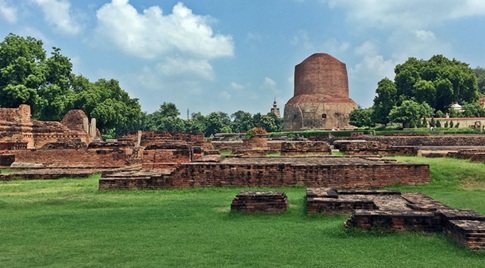(Prelims: History of India)
(Mains, GS Paper-1: Salient aspects of Art Forms, Literature and Architecture from Ancient to Modern Times in Indian Culture) |
Context
Recently, India nominated Sarnath for inclusion in the UNESCO World Heritage List for the 2025-26 cycle.

Sarnath: An Overview
- Sarnath is one of the four holiest pilgrimage sites of Buddhism, located approximately 10 km northeast of Varanasi.
- It is the place where Lord Buddha delivered his first sermon. In ancient texts, Sarnath was referred to as ‘Mṛgadvā’ or ‘Rishipatna’.
- This site witnessed the formation of the Buddhist Sangha. The Ashokan Pillar here is now the national emblem of the Republic of India.
Ashoka's Patronage
- The Mauryan Emperor Ashoka (268-232 BCE) bestowed special importance on Sarnath.
- He erected the ‘Lion Pillar’ here, which now serves as the national emblem of India.
- Ashoka built several monasteries and stupas, the most famous being the ‘Dhamek Stupa’, symbolizing Buddha’s first sermon.
Reconstruction during Kushan and Gupta Periods
- The Kushan (1st-4th century CE) and Gupta (3rd-6th century CE) rulers renovated the Ashokan structures and built new temples and monasteries.
- A thriving Buddhist monastery existed here until the 12th century.
Destruction of Sarnath
- Historians believe that Sarnath was destroyed in the 12th century.
- According to the archaeologist Alexander Cunningham, the temples, sculptures, and monasteries were burnt down, and the monks were killed.
- Many scholars believe that this destruction occurred during the invasion of Qutb-ud-din Aibek (1193), when thousands of temples in Varanasi were demolished.
- Some scholars believe that an attempt was made to build a Shaivite temple here, but the plan remained incomplete due to Muslim invasions.
- After this destruction, Sarnath remained in ruins for approximately 700 years, and Buddhism almost disappeared from India.
Modern Rediscovery
- In the late 18th century, laborers working for Jagat Singh, the minister of Raja Chitrasen of Banaras, were removing bricks and stones from the site.
- During these excavations, the base of a Buddha statue and two stone fragments were discovered.
- In 1799, Jonathan Duncan reported these discoveries, which piqued the interest of British archaeologists.
- In 1835-36, Alexander Cunningham conducted excavations, and Sarnath was recognized as the site of Buddha's first sermon.
- In 1904-05, archaeologist Friedrich Otto Reil conducted a scientific excavation, discovering 476 sculptures and 41 inscriptions.
Sarnath Today
- Today, Sarnath is considered one of the four major Buddhist pilgrimage sites, along with Lumbini, Bodh Gaya, and Kushinagar.
- According to government data, 8,43,836 people visited the site in 2024-25.
- The Government of India and the ASI (Archaeological Survey of India) are working towards its inclusion in the UNESCO World Heritage List.
Conclusion
Sarnath is not only a major site of Buddhism but also a living symbol of Indian history and culture. It reminds us of the path of non-violence, compassion, and wisdom. The Lion Capital here connects the foundation of the Indian Republic with Buddhist heritage. Its inclusion in the UNESCO list will further enhance the global recognition of India's cultural heritage.


